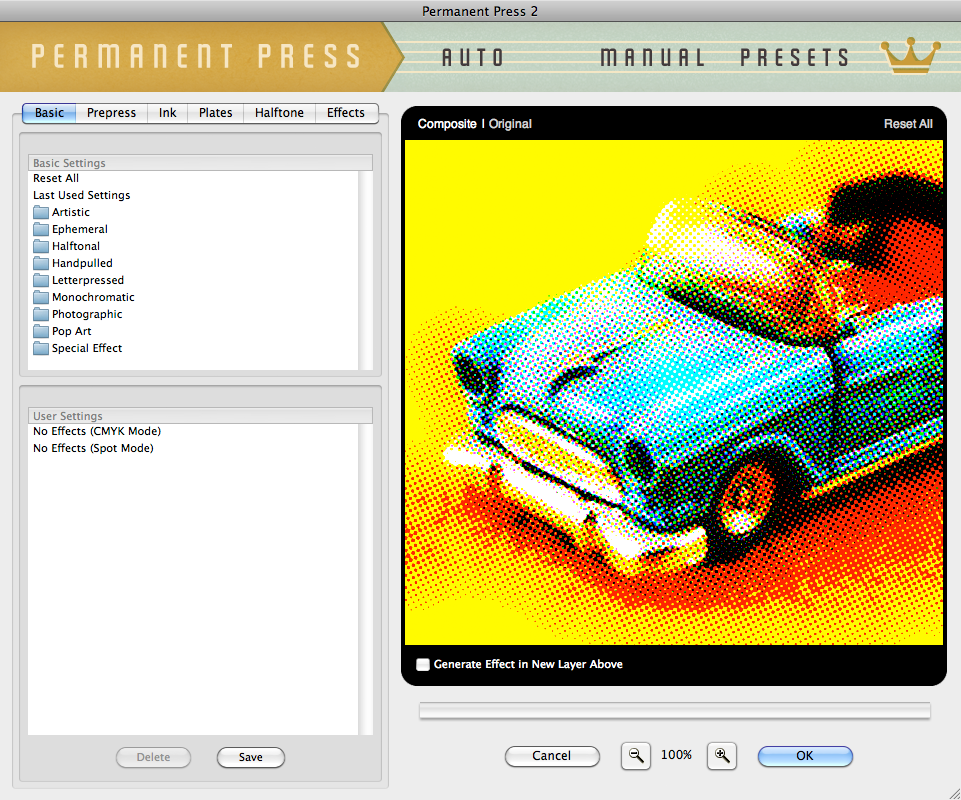Let's Learn About Permanent Press 2
Basic Settings
Permanent Press 2 always launches in the Basic tabbed section as identified by the highlighted tab in the GUI. It first performs calculations on the image and applies either the default settings or the Last Used Settings to the loaded image.

|
Basic Settings - You'll first notice on the left side of the GUI the Basic dialog which allows you to apply any of our factory preset settings to your image. Use the Reset All setting to reset all tabbed sections allowing you to start from scratch or select the Last Used Settings to apply the last known effect settings to the image you're working with. To apply any of our factory preset settings, click on any of the folders which are organized by style to access the presets then simply click on the setting name in the dialog box to apply the preset.
User Settings - Below the Basic Settings dialog is the User Settings dialog which allows you to save or apply previously saved settings to the image you're working with. You'll notice by default we've included two very handy No Effect presets which will quickly allow you to apply either the CMYK or Spot color mode to your image with no additional effects applied. Use either preset to quickly apply a color mode without any additional effects applied then fine-tune as you wish.
Once you've created an effect setting you like, click the Save button, name the setting and click OK to save this setting. To recall and apply a previously saved setting, simply click on the setting name in the dialog box. To delete a setting, simply click its name in the dialog box and click the Delete button.
Working with the Preview Window
- Preview Options - Above the preview window at left, you'll notice some viewing options. By default the Composite option is selected to show you what all combined tabbed section effects look like applied to the image. At any time you can click the Original option to toggle between the unaffected image and a preview of the filtered image with all effects applied.
- Reset All - Reset All is located above the preview window on the right. When clicked, it will reset all effects on every tabbed section to their default state.
- Magnifying the Preview - Below the preview window, you'll see the magnification controls. By clicking the appropriate icon (- or +), you can decrease or increase the magnification of the preview window. The current level of magnification is shown between the magnification icons. If you prefer keyboard shortcuts, you can simply hold down the Command (Apple) key (or the Ctrl key on Windows) then press the plus sign (+) or the minus sign (-) respectively to zoom in or out of your image.
- Moving the Preview - When you have increased magnification and wish to view the texture effect on the rest of the image not visible in the preview window, simply move your mouse into the preview window and click and drag your image around to reveal the effect on your image.
- Re-positioning ink plates - To modify the position of an ink plate on your image, hold down the Command (Apple) key (or the Ctrl key on Windows) then click and drag within the preview window to reposition the center of the effect. You can change which ink plate you're repositioning via any ink plate selector dialog along the top of the plug-in.
- Generate Effect in New Layer Above* - Simply enable this option if you want the plug-in to duplicate your original image and apply the filtered version on a new layer above the original image leaving it intact.
* NOTE - This option is only displayed in certain versions of Adobe Photoshop and other imaging applications that support layering and automation.
Pro Tip - Adobe Photoshop users may use keyboard shortcuts to instantly change the zoom magnification. To fit the full image within the preview window, simply hold down the Command (Apple) key (or the Ctrl key on Windows) then press the number zero (0) on the keyboard. To view the image at 100% size, hold down the Command (Apple) key (or the Ctrl key on Windows) then press the number one (1) on the keyboard.